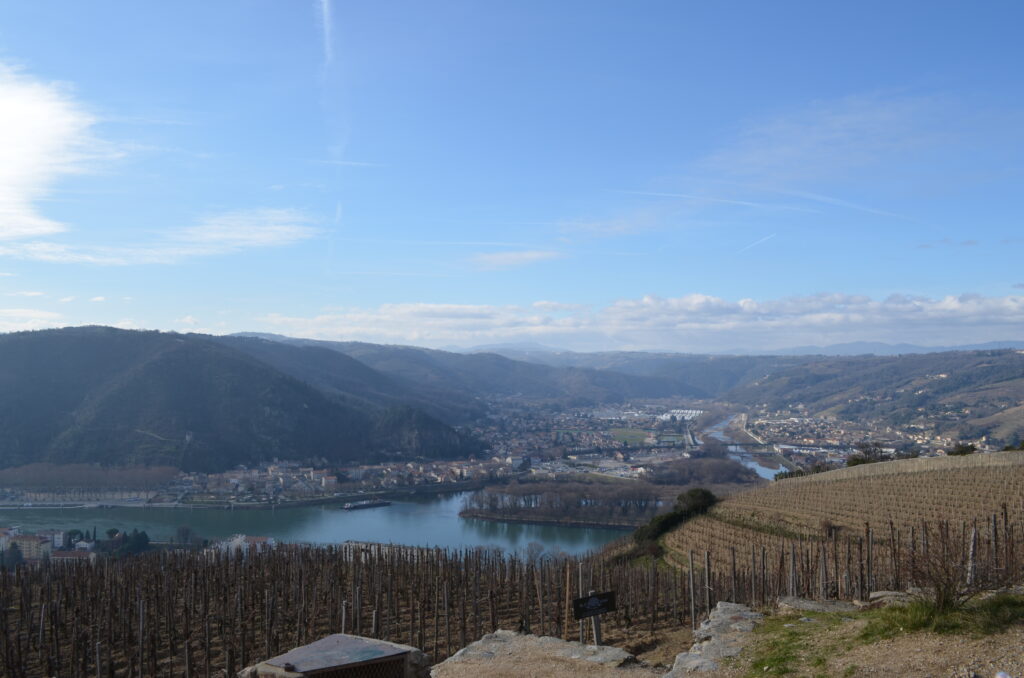
The Rhône Valley is one of our favorite wine tourism destinations. Start with a night in Lyon, with its fabulous gastronomic scene and Roman ruins, and then meander down the valley, sampling its incredible foods and wines along the way. The northern Rhône, with its steep granite hillsides, is Syrah country, unsurprisingly since the grape is native to this region. After a break where no vines are grown you reach the southern Rhône, where the terrain flattens out and the red wines are Grenache, Syrah, and Mourvèdre blends.
- Sure, there are some nice white wines in the Rhône Valley, but none of the caliber of the reds.
- Rhône Syrah-based wines are very food friendly, and they pair particularly well with most meats. If you’re looking for a great wine to pair with Texas BBQ – look no further!
Among the northern Rhône’s eight cru appellations is the relatively obscure Saint-Joseph AOC, shown above looking upriver from Hermitage. This is where you'll find some of the Rhône's best wine bargains, one of which we discuss below. The AOC runs along the river for about 40 miles and, because of its large size and varied terroir, the style and quality of its wines vary. Think of Saint-Joseph as an umbrella appellation that aggregates multiple areas that are too small to merit their own appellations. Generally, southern Saint Joseph tends to produce higher quality, full-bodied wines, while the northern area tends to produce medium-bodied and less intense wines.
- A great thing about Saint-Joseph wines is that they are excellent when young, unlike many Syrah wines that need years in the bottle to develop and for the tannins to soften. So why not have a $95 Saint-Joseph rouge today while you're waiting for your $700 bottle of Hermitage to develop. . . better still, grab 7 bottles of the Saint-Joseph and have a party.
Our featured wine is the Domaine Jean-Louis Chave 2019 St. Joseph Rouge ($95 retail). Jean-Louis Chave, the sixteenth generation of a renowned Rhône winemaking family, has led the resurgence in St. Joseph wines over the past several decades. At considerable expense and effort, he's restored family vineyards in Saint-Joseph that had been abandoned for more than 150 years. He brings a focus on quality to his wines, and follows a family tradition of things that a winemaker just can't do: use chemicals in the vineyard; use too much new oak; use commercial yeasts. Chave wants the vineyards to speak for themselves, to convey a sense of place. The Saint-Joseph Rouge succeeds admirably in this.
- This dry red wine is deep purple and full-bodied. It features enticing aromas of blackberry, blackcurrant, pepper, spice, and a hint of violet. On the palate, it’s full bodied and nicely balanced, with nice acid and notes of blackberry, blueberry, pepper, and spice. It has mild, sandy tannins and a long, pleasant finish.
- The verdict: we loved this wine and will add more to our cellar. The wine benefits from decanting for an hour or so, and while it's pleasant enough by itself it’s best enjoyed with a hearty dish. We paired it with a ribeye, and it was a perfect.
- If $95 is a bit too steep, try the Domaine Jean-Louis Chave Sélection Saint-Joseph Offerus-- a nice wine made from grapes purchased from local growers and produced at the Chave estate; it retails around $40. If you can find it, grab some! If your wine shop doesn't have either of the Chave wines, other good Saint-Joseph producers include Guigal, Chapoutier, and Delas.
Cheers!
